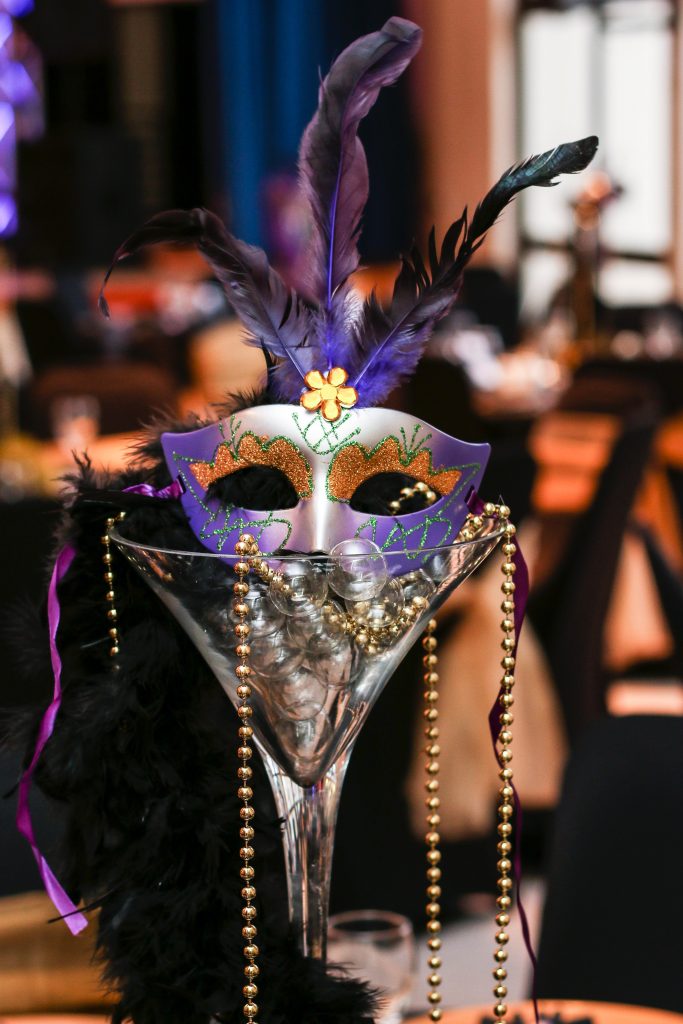
Mardi Gras is well under way! If you have not experienced the traditions and the pageantry of Mardi Gras, add it your bucket list now! We promise you won’t regret it.
Table of Contents
What is Mardis Gras?
Mardi Gras is the day before Ash Wednesday, when the Christian season of Lent begins. This day is also called Shrove Tuesday. A name that comes from the practice of “shriving”—purifying oneself through confession—prior to Lent. For many Christians, Shrove Tuesday is a time to receive penance and absolution.
You’ll sometimes hear Mardi Gras referred to as “Carnival”. Technically, this term refers to the period of feasting that begins on January 6. The Feast of the Epiphany and ends on Mardi Gras. In cities such as New Orleans , Rio Janeiro, and Venice, there are week-long festivals leading up to Mardi Gras.
What does Mardi Gras mean?
In French, Mardi Gras means “Fat Tuesday.” (Mardi is the word for Tuesday and gras is the word for fat.)
This name comes from the tradition of using up the eggs, milk, and fat in ones pantry. They were forbidden during the 40-day Lenten fast, which begins the next day Ash Wednesday. It ends on Holy Thursday; three days before Easter Sunday.
Therefore, a big part of Shrove Tuesday is eating an abundance of delicious fried food—especially donuts and Shrove Tuesday Pancakes!
The word “carnival” also comes from this feasting tradition. In Medieval Latin, carnelevariummeans “to take away or remove meat”, from the Latin carnem for meat. During Lent, Catholics traditionally gave up meat during the Lenten season and mainly ate fish.
Mardi Gras in New Orleans
Most famous of these is Mardi Gras in New Orleans. The Rio Carnival in Rio de Janeiro, Brazil. Where hundreds of thousands of people descend on the cities in question to have a good time and take part in the festivities.
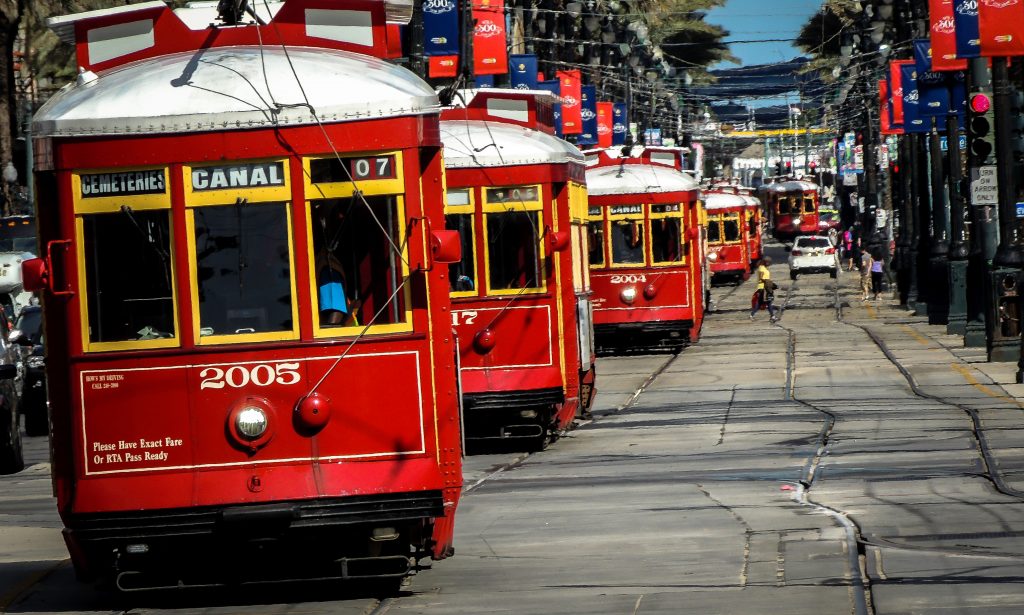
The US custom of celebrating Mardi Gras started in Mobile, Alabama in 1703 by a Frenchman. Mobile still holds Mardi Gras celebrations throughout the year. It has an excellent Mardi Gras museum. However, New Orleans has definitely eclipsed Mobile as the US capital of Mardi Gras now.
History of Mardi Gras in New Orleans
n 1870, Mardi Gras’ second Krewe, the Twelfth Night Revelers, was formed. This is also the first recorded account of Mardi Gras “throws.”
Newspapers began to announce Mardi Gras events in advance. They even printed “Carnival Edition” lithographs of parades’ fantastic float designs. After they rolled, of course – themes and floats were always carefully guarded before the procession. At first, these reproductions were small, and details could not be clearly seen. But beginning in 1886 with Proteus’ parade “Visions of Other Worlds,” these chromolithographs could be produced in full. They were saturated color, doing justice to the float and costume designs of Carlotta Bonnecase, Charles Briton and B.A. Wikstrom. Each of these designers’ work was brought to life by talented Parisian paper-mache’ artist Georges Soulie’. For 40 years he was responsible for creating all of Carnival’s floats and processional outfits.
King of Carnival
1872 was the year that a group of businessmen invented a King of Carnival, Rex. This was to preside over the first daytime parade. To honor the visiting Russian Grand Duke Alexis Romanoff; the businessmen introduced Romanoff’s family colors of purple, green and gold as Carnival’s official colors. Purple stands for justice; gold for power; and green for faith. This was also the Mardi Gras season that Carnival’s improbable anthem, “If Ever I Cease to Love,” was cemented. This was due in part to the Duke’s fondness for the tune.
The following year, floats began to be constructed entirely in New Orleans instead of France. Culminating with Comus’ magnificent “The Missing Links to Darwin’s Origin of Species”. This exotic paper-mache’ animal costumes served as the basis for Comus. Used to mock both Darwin’s theory and local officials, including Governor Henry Warmoth. In 1875, Governor Warmoth signed the “Mardi Gras Act. Establishing Fat Tuesday a legal holiday in Louisiana, which it still is.
Like Comus and the Twelfth Night Revelers; most Mardi Gras krewes today developed from private social clubs with restrictive membership policies. Since all of these parade organizations are completely funded by their members; New Orleanians call it the “Greatest Free Show on Earth!”
Parades in New Orleans
There are normally around 80 parades scheduled in New Orleans during Mardi Gras. Running from the 6th January through to Mardi Gras itself. So whenever you visit, you should be able to see a parade.
Our recommendation is to try and see at least one of the parades by one of the “Super Krewes”. These tend to be very visually impressive.
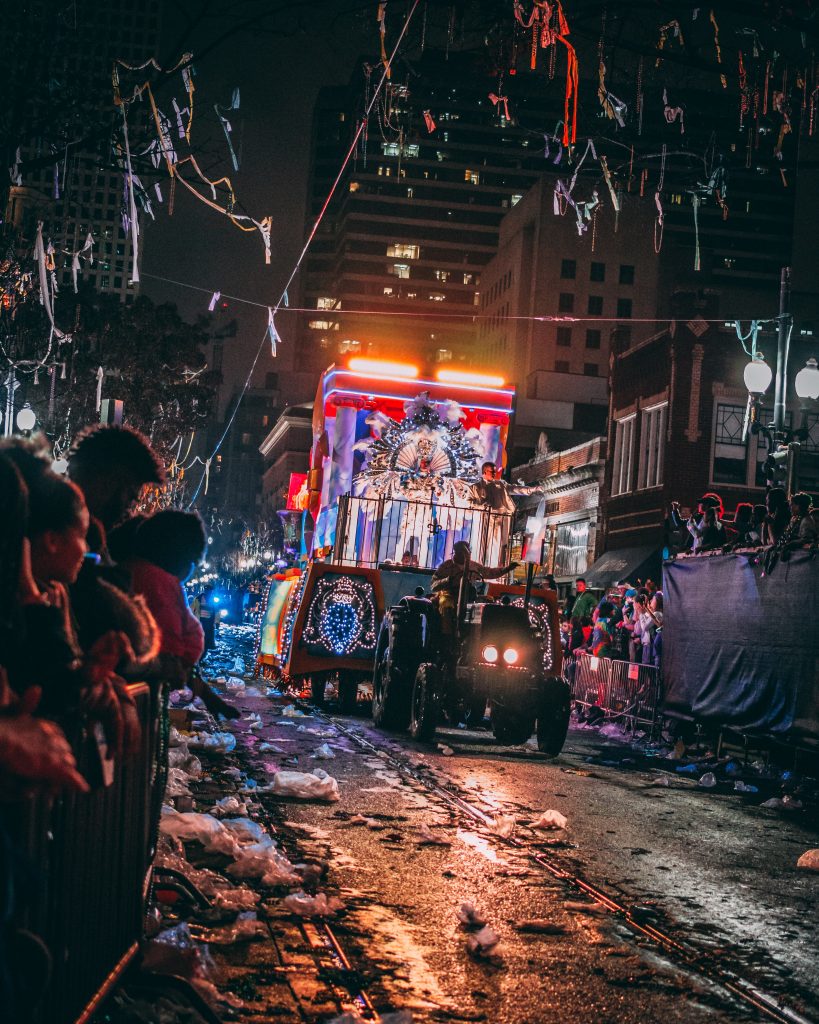
The three super krewes in the city of New Orleans are Orpheus, Bacchus and Endymion. While there’s no formal definition of a super krew; they usually have at least 1,000 members and at least 500 riders participating in the parades. Making for quite the spectacle of floats!
Where to Watch Parades
If you are not on a parade float, there are many places where you can watch the awesome pageantry of Mardi Gras.
The most famous balconies in New Orleans during Mardi Gras are those which are found on Bourbon Street in the French quarter. However, since the 1960s the major motorized parades haven’t gone down Bourbon Street as it is too narrow. There are still some parades that come through here, but they are all foot based.
This hasn’t stopped this part of New Orleans becoming the centre of the Mardi Gras party. With costumed party goers flocking to the street itself and the bars that line it; many of which have balconies overlooking the street. Be aware that the action here can get a little adult. You might want to steer clear if you’re looking for a more family friendly experience.
Good venues in Bourbon Street with balconies include Bourbon Vieux, Bourbon Cowboy and Cat’s Meow.
If you want to watch the larger parades from a balcony; there are a number of venues to consider, including bars and hotels. Generally these venues will have some sort of Mardi Gras package or booking requirement. There will invariably be a fee for watching Mardi Gras from these locations.
If you want to watch Mardi Gras from a balcony, hotel or restaurant along the route, advance booking is absolutely essential.
Street Locations
you can also watch the Mardi Gras parades from anywhere along the parade routes themselves. The routes can be miles long. There are a lot of options for finding a spot to watch the route from. Here are some spots to consider:
- Lee Circle – this traffic circle offers a unique view of the parades going up and down St. Charles. Right next to the aforementioned Holiday Inn
- Polymnia & St. Charles – this intersection is by the Avenue Pub, which has an excellent balcony for watching. If you don’t get a spot on the balcony, this street location is another excellent, if very busy, choice
- Canal Street – after leaving Lafayatte Square many parades turn onto Canal Street. Just try and stay on the east side of the street, as otherwise you can become stuck once the parades start
- St Charles Ave – most of the parades run down St. Charles Ave, so a good option is just to wander down this street until you find yourself a spot and make it your own!
Watching from the street is definitely an authentic experience, and we’d recommend watching at least one parade from the street.
Just be aware that for the more popular parades. The best spots to watch from can fill up hours in advance. People even bring little ladders to stand on for optimum viewing.
Watching from the street is free, and can have a great atmosphere as you jostle for throws from the parade floats. However, unless you bring a chair, you’ll likely be standing for a prolonged period. Whilst there are public portable restrooms in some locations, they are not everywhere.
Mardi Gras Balls
While most people think of parades when they think of Mardi Gras, there are plenty of other traditions too. The King and Queen of each krewe work all year long for the big, spectacular ball. Their identity is a closely guarded secret and part of the mystique until the night of the Ball.
Most of the balls are a formal and private affair for the krewe. Debutantes are introduced at the Ball Tableau as a formal introduction to society. In climbing the social ladder, children start by serving as pages to the court. Women dress in ball gowns and hope to be issued a “call-out” card. If a debutante is fortunate enough to receive one; she is seated in a select area. She waits her turn to be “called out” for a dance by the krewe member who sent the card. A night of dining and dancing with a prince in formal attire – what a dream!
Attendance at the older, more aristocratic balls is by invitation only. No one really feels left out if they don’t receive an invitation, though. Many prominent people aren’t invited, including governors wanting to attend. Ball invitations were originally die-cut and printed in Paris. Even today they can be quite colorful and valuable works of art. Invitations can also be collectors’ items framed for their beauty and considered.
Super Krewe Balls
Some large parades produce an indoor extravaganza the night of their parade. While all balls are exciting events, Bacchus, Orpheus, and Endymion, the three “super krewes,” put on the best balls by far!
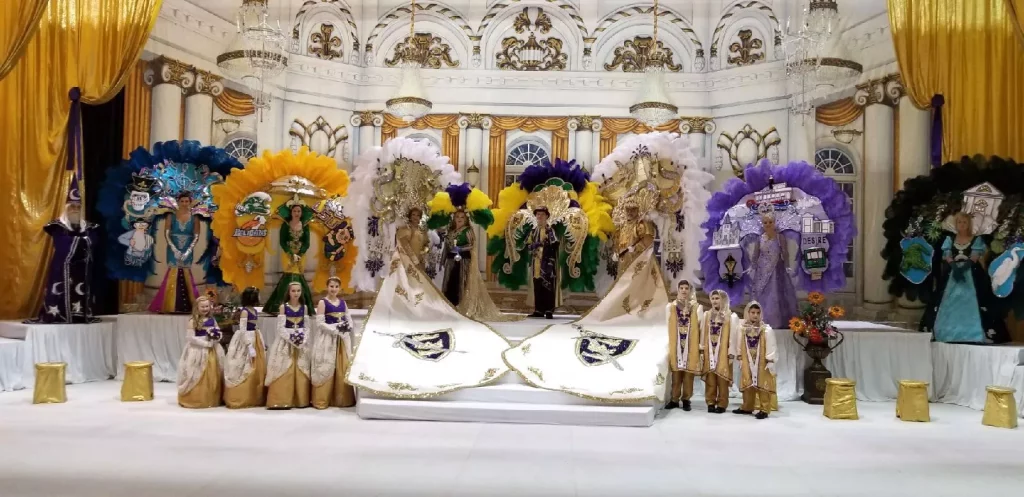
In Greek mythology, Bacchus is the god of wine and vegetation—and they host a celebration fitting of its namesake god. Mardi Gras balls were exclusive events closed off from most people outside of New Orleans society until this krewe revolutionized the event. In 1949, Edward Brennan Sr. created the krewe, a carnival Ball open to tourists. As they say, the first is the best because this event has become the talk of the town for tourists and locals alike!
The largest of all krewes, including the “super krewes”, the Krewe of Endymion hosts an after parade extravaganza that rivals any event of its kind. Held in the Superdome, the krewe hosts top name performers for entertainment with tens of thousands in attendance.
The appropriately names Krewe of Orpheus puts on a black-tie affair full of music and merriment at the Convention Center. It was the first of the super krewes open to both men and women. The Lundi Gras spectacle is legendary for having top notch entertainment from some of the hottest superstars.
This is a wonderful way to experience Mardi Gras. Everyone dresses formally and enjoys the parade, entertainment, and food all night long.
King Cake
While you are in New Orleans, you have to try the famous King Cake. Mardi Gras and king cakes go hand in hand. Especially in New Orleans where hundreds of thousands of king cakes are enjoyed at parties, offices and in homes every year.
According to the Christianity, Jesus first showed himself to the three wise men and to the world on January 6th. Also known as Twelfth Night or the Epiphany. The word “Epiphany” is from the Greek word “to show”. This is the day Mardi Gras season – hence king cake season – begins.
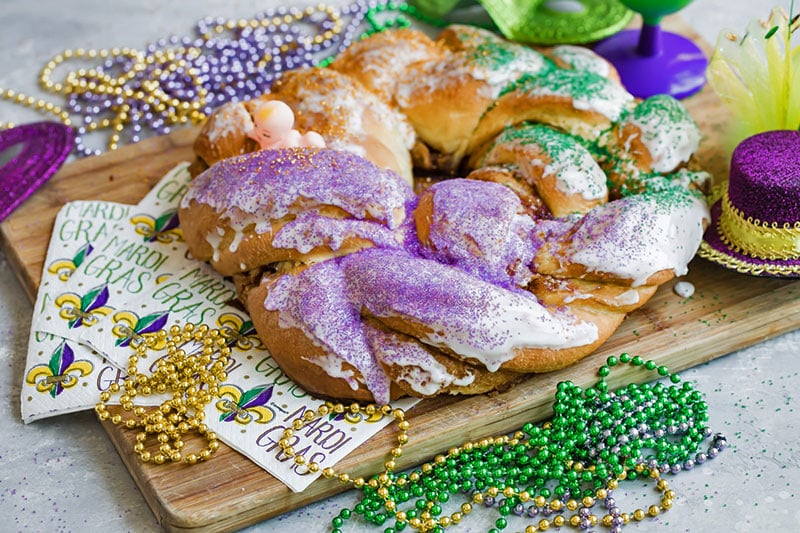
Each king cake has a tiny baby inside. Generally plastic now, but it’s possible the baby might be made of porcelain or even gold. In the past, you might have found an item such as a coin, bean, pecan or pea in a king cake. The lucky person who receives the slice of cake with the baby has the next king cake party. Or brings the next cake for the office.
The king cake tradition is believed to have been brought over from France in the 1870s. Originally, king cakes were a simple ring of dough with a small amount of decoration. After the rich dough is braided and baked, the top of the cake is covered with delicious sugar toppings in the traditional Mardi Gras colors of purple, green and gold (purple for “justice,” green for “faith” and gold for “power”). In more recent years, many bakeries have been creative, topping their cakes with different flavors of cream cheese and fruit fillings and offering them in various shapes. King cakes are often served at New Orleans weddings as the groom’s cake.
Carnival in Rio De Jainero
Taking a trip to Rio de Jainero to partake in the Carnival festivities is the experience of a lifetime. Rio de Janeiro’s Carnival celebration is undoubtedly the planet’s most ostentatious, bombastic, mind-blowing spectacle, uniting millions of Brazilians and visitors within the lush environs of the Marvelous City in rapturous merriment over the 5 days preceding the pious Catholic season of Lent. The party happens every February or March, ending 40 days before Easter and commemorating the close of the long, hot Brazilian summer with a lavish, world-renowned Carnival parade in the Sambadrome. Also on tap are popular itinerant street parties called blocos, and chic, high-gloss costumed balls called bailes. Non-Carnival-related commerce and industry in Rio completely shut down for the fun, so there is no escape from the intense debauchery.
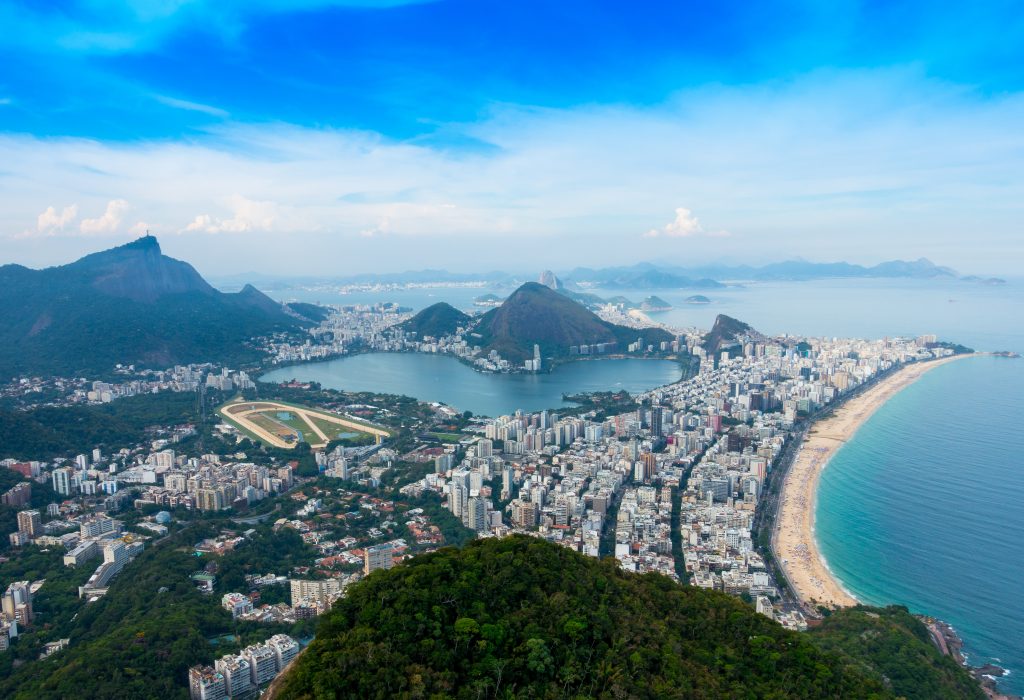
Carnival Parade
With a parade tradition stretching as far back as the 1930s, Rio is home to over 70 samba schools. Representing modest neighborhoods from throughout the metropolitan area, the largest and most creative schools (collectively, the Grupo Especial) end up competing for cash and nationwide fame during a 2-night bonanza of sound and spectacle in Rio’s one-of-a-kind Carnival stadium, the Sambadrome. First opened in 1984 and designed by Brazil’s architect extraordinaire, Oscar Niemeyer, the nearly 2,300-foot-long stadium, with its distinctive arch — jokingly referred to as a concrete thong — holds up to 90,000 raucous spectators who pay anything from R$10 to over R$5,000 for the privilege of cheering on their favorite schools amid the unmatched energy of Carnival.
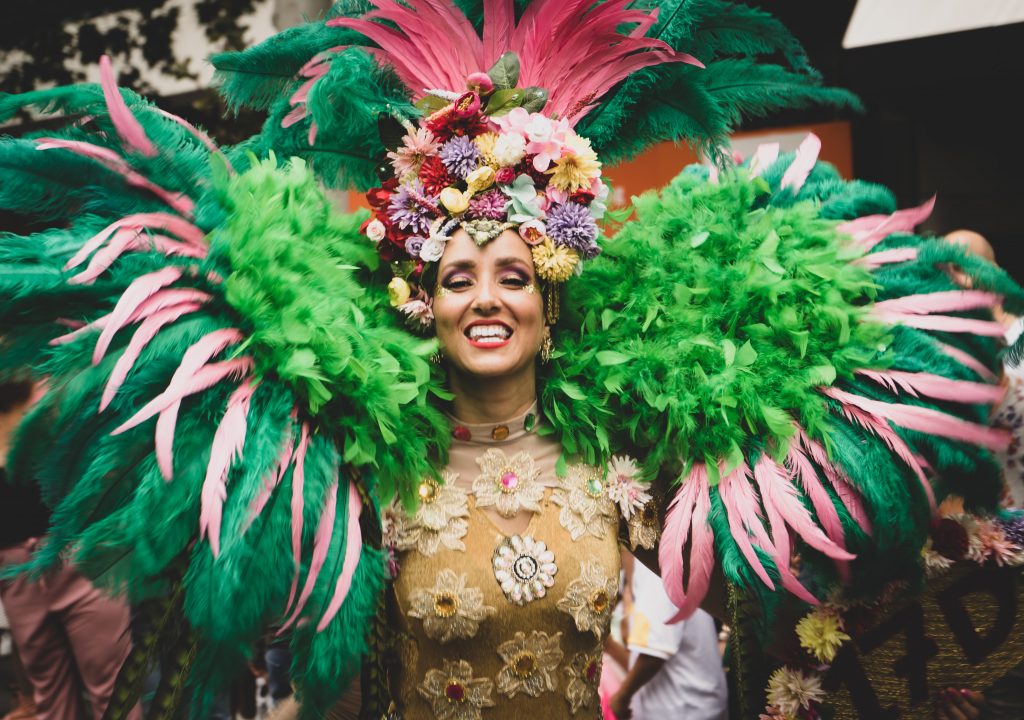
The Competition
The competition itself, televised nationally late into the night on the Sunday and Monday of Carnival. It consists of a series of performances in which each of the top 12 samba school’s roughly 3,000 members sing and dance nonstop. Calculated precision for 90 minutes, dressed in dazzling costumes atop monumental floats and slowly parading down the length of the Sambadrome to the wild cheering of fans and the intense scrutiny of the parade judges.
The judges consider each school’s performance in categories such as song lyrics, drumming cadence and precision, costumes, overall harmony and allegorical theme, with the lowest scoring schools relegated to the second-string Grupo de Acesso. Themes include whimsical homages to various world cities, historical events, and Brazilian personalities — 2012’s winning samba school, Unidos da Tijuca, clenched the title with a celebration of popular Brazilian folk singer Luiz Gonzaga. Other contenders include some of Rio’s most revered samba schools, such as perennial favorites Mangueira, Beija-Flor, and Portela.
Blocos
Rambunctious street parties called blocos command Rio’s complete attention: The celebrations run from 8 in the morning to almost 8 the next morning. Donning homemade costumes and downing inordinate amounts of beer and cachaça (Brazilian rum), crowds numbering in the hundreds of thousands doff ideas of personal space and congregate throughout Centro and the Zona Sul to flirt and frolic to the beats of Carnival parade drummers, kitchen utensils banged together, old-school boom boxes blasting pop music or just the rhythm of the multitudes.
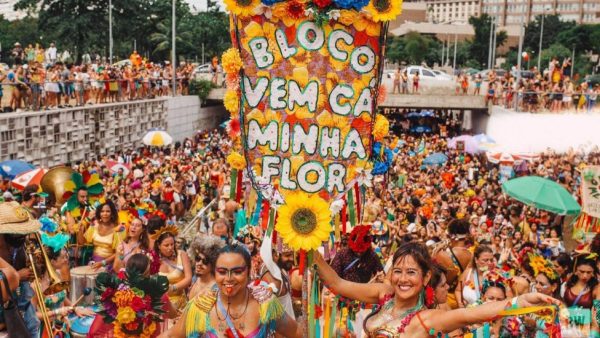
Where to Find a Bloco
Blocos pop up throughout Rio, so you won’t have any trouble finding or joining one, but the biggest must-dos include Centro’s raucous Cordao do Bola Preta, the humorously named Volta, Alice! (Come Back, Alice!) in Rio’s Zona Sul area of Laranjeiras, Flamengo’s Beatles-themed Bloco do Sargento Pimenta, the funky-fresh Afroreggaein Rio’s Ipanema neighborhood, and the absolutely massive Monobloco, wrapping things up in Centro (check individual websites for dates and times). The parties are intense and if you don’t like rubbing elbows with strangers, just stay home. And keep your cash stashed in your underwear!
Traveling to Brazil
Being the most famous holiday in Brazil, Carnival draws over a million tourists every year (1.5 million flocked to Rio de Janeiro alone for Carnival in 2019; Salvador around 800k). So, if you plan to visit any of the more popular destinations, you’ll definitely want to start planning in advance!
If you plan to visit Rio de Janeiro or Salvador Carnival, it is recommended to book flights and accommodation about 4-6 months in advance. If you plan to attend the Samba Parade, try to book these tickets shortly after your main travel plans. While there will usually be a few tickets up to the last couple weeks, the best tickets sell out early and prices can increase significantly as the date approaches. If you want to walk in the Sambodrome parade in Rio, you will need to book those tickets about 6 months before as spaces are very limited (also keep in mind that you will need a couple additional days in Rio to pick up costumes and practice- make sure to factor this in when booking your flights, etc!).
If you’re planning to visit one of the other Carnivals, it is still advisable to begin booking flights and accommodations around 4 months in advance, but it’s a bit more flexible.
Many guests enjoy combining a Brazilian Amazon cruise with their carnival trip. There are many different types of boats and itineraries to choose from. Whichever city you visit, or however you participate, you can be guaranteed that a trip to any Carnival in Brazil will be unlike any other experience!
Other Brazilian Celebrations
Other popular Carnivals in Brazil take place in the state of Pernambuco and São Paulo. In Pernambuco you’ll find major Carnival celebrations in the capital of Recife and the colonial town of Olinda. Here, the style of dance is largely African-influenced, and events are much more informal. All events take place in the morning, unlike the all day and night parades in Rio and Salvador, and they do not include any group competitions like the aforementioned cities.
Carnival in Sao Paulo takes place in the Anhembi Sambodrome in São Paulo, two days before the similar parade in Rio de Janeiro. Similarly, many different groups compete with wild floats, dancers, music and costumes for the highly-sought-after winning title. For those who love this type of performance, it’s possible to see the São Paulo parades on Friday and Saturday night, then make it to Rio de Janeiro for the primary Sunday and Monday night parades.
